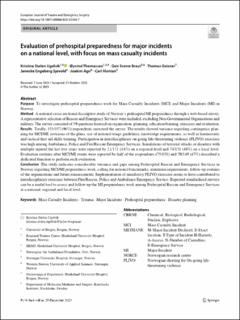| dc.contributor.author | Ugelvik, Kristina Stølen | |
| dc.contributor.author | Thomassen, Øyvind | |
| dc.contributor.author | Braut, Geir Sverre | |
| dc.contributor.author | Geisner, Thomas | |
| dc.contributor.author | Sjøvold, Janecke Engeberg | |
| dc.contributor.author | Agri, Joakim | |
| dc.contributor.author | Montan, Carl | |
| dc.date.accessioned | 2024-01-09T07:42:16Z | |
| dc.date.available | 2024-01-09T07:42:16Z | |
| dc.date.created | 2024-01-05T14:53:07Z | |
| dc.date.issued | 2023 | |
| dc.identifier.citation | European Journal of Trauma and Emergency Surgery. 2023, . | en_US |
| dc.identifier.issn | 1863-9933 | |
| dc.identifier.uri | https://hdl.handle.net/11250/3110476 | |
| dc.description.abstract | Purpose:
To investigate prehospital preparedness work for Mass Casualty Incidents (MCI) and Major Incidents (MI) in Norway.
Method:
A national cross-sectional descriptive study of Norway’s prehospital MI preparedness through a web-based survey. A representative selection of Rescue and Emergency Services were included, excluding Non-Governmental Organisations and military. The survey consisted of 59 questions focused on organisation, planning, education/training, exercises and evaluation.
Results:
Totally, 151/157 (96%) respondents answered the survey. The results showed variance regarding contingency planning for MCI/MI, revisions of the plans, use of national triage guidelines, knowledge requirements, as well as haemostatic and tactical first aid skills training. Participation in interdisciplinary on-going life-threatening violence (PLIVO) exercises was high among Ambulance, Police and Fire/Rescue Emergency Services. Simulations of terrorist attacks or disasters with multiple injured the last five years were reported by 21/151 (14%) on a regional level and 74/151 (48%) on a local level. Evaluation routines after MCI/MI events were reported by half of the respondents (75/151) and 70/149 (47%) described a dedicated function to perform such evaluation.
Conclusion:
The study indicates considerable variance and gaps among Prehospital Rescue and Emergency Services in Norway regarding MCI/MI preparedness work, calling for national benchmarks, minimum requirements, follow-up routines of the organisations and future reassessments. Implementation of mandatory PLIVO exercises seems to have contributed to interdisciplinary exercises between Fire/Rescue, Police and Ambulance Emergency Service. Repeated standardised surveys can be a useful tool to assess and follow-up the MI preparedness work among Prehospital Rescue and Emergency Services at a national, regional and local level. | en_US |
| dc.language.iso | eng | en_US |
| dc.publisher | Springer | en_US |
| dc.rights | Navngivelse 4.0 Internasjonal | * |
| dc.rights.uri | http://creativecommons.org/licenses/by/4.0/deed.no | * |
| dc.title | Evaluation of prehospital preparedness for major incidents on a national level, with focus on mass casualty incidents | en_US |
| dc.type | Peer reviewed | en_US |
| dc.type | Journal article | en_US |
| dc.description.version | publishedVersion | en_US |
| dc.rights.holder | © The Author (s) 2023 | en_US |
| dc.source.pagenumber | 0 | en_US |
| dc.source.journal | European Journal of Trauma and Emergency Surgery | en_US |
| dc.identifier.doi | 10.1007/s00068-023-02386-7 | |
| dc.identifier.cristin | 2221537 | |
| cristin.ispublished | true | |
| cristin.fulltext | original | |
| cristin.qualitycode | 1 | |

